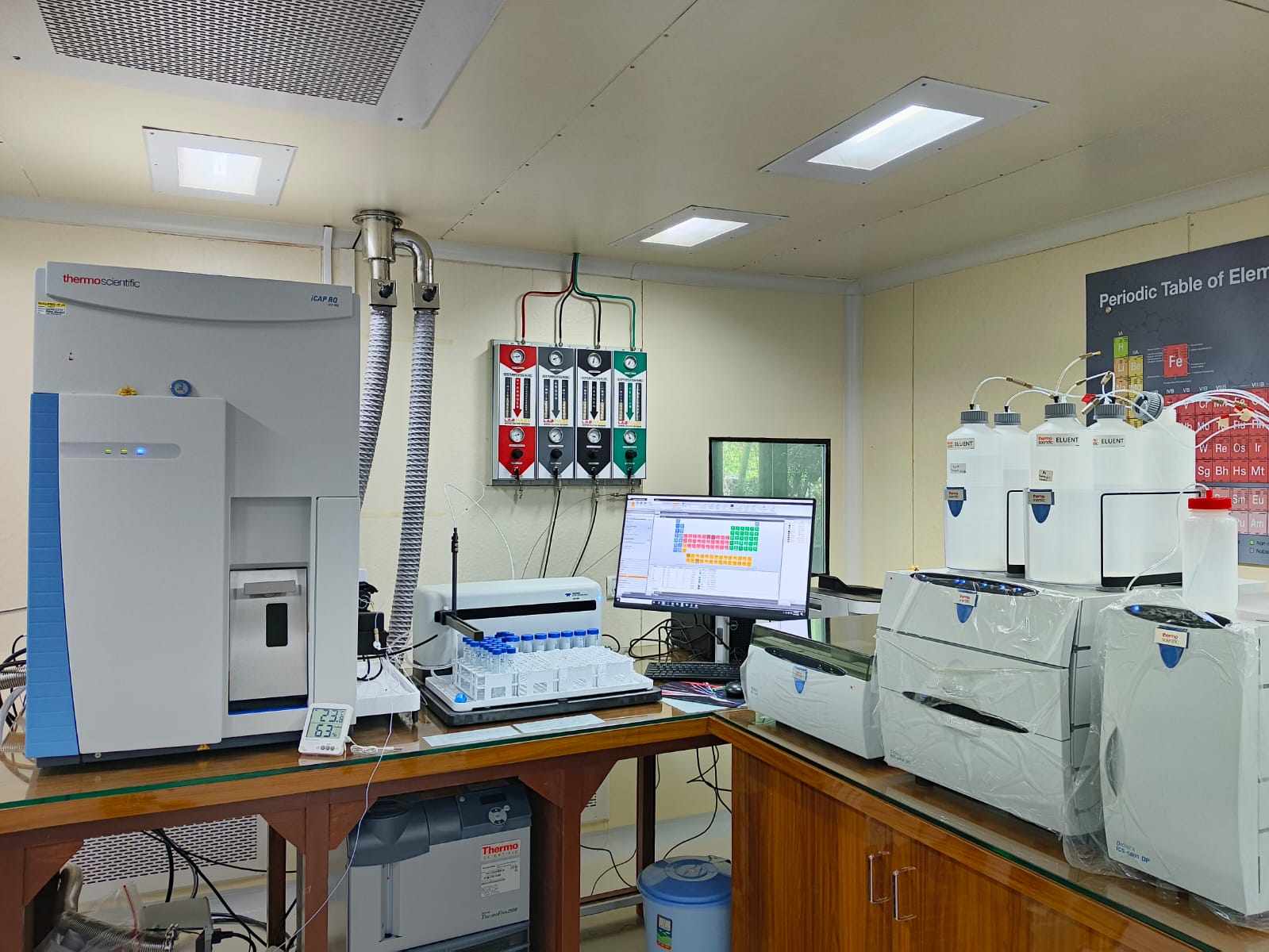| |
|
Ion Chromatography coupled with
Inductively Coupled
Plasma Mass Spectrometry(IC-ICPMS)
 Kindly download Material Safety Data
sheet and submit the hardcopy of filled sheet along with your sample Kindly download Material Safety Data
sheet and submit the hardcopy of filled sheet along with your sample
|
|
|
Make
|
: Thermo Fisher,
|
|
Model
|
: ICS 6000 Ion
Chromatography
iCAP RQ ICP-MS
|
|
Detailed Specifications
|
:
|
ICS 6000 Ion Chromatography System
|
|
(1)
|
Quaternary Gradient Pump
|
|
(2)
|
Pressure range: 0–41 MPa
(0–6000 psi)
|
|
(3)
|
Temperature Range: 18 to 40
°C
|
|
(4)
|
CD Conductive Detector with
integrated flow cell
- Resolution: 0.00238 nS/cm
- Digital Signal Range: 0–18,000 µS/cm
|
|
(7)
|
Columns for anion and
cation analysis
|
|
(8)
|
Columns for Cr, As, Hg etc.
speciation analysis
|
|
(9)
|
Dionex AS-DV Autosampler
|
iCAP RQ ICP-MS
|
|
(1)
|
Digital, Solid-state RF
Generator with dynamic frequency
|
|
(2)
|
Computer-controlled plasma
positioning in x, y, and z dimensions
|
|
(3)
|
Plasma TV for simplified
plasma optimization
|
|
(4)
|
Proprietary QCell with
Flatapole technology
|
|
(5)
|
Collision/reaction cell
technology (CRC) with two CCT gas MFCs
|
|
(6)
|
Mass Range: 2–290 amu
|
|
(7)
|
Qtegra Control software
platform
|
|
(8)
|
ASX560 Autosampler
|
|
 |
|
|
IC-ICP-MS stands for Ion Chromatography coupled with Inductively Coupled Plasma Mass
Spectrometry. It's a powerful analytical technique used for speciation analysis—that
is, identifying and quantifying different chemical forms of elements, especially
metals and metalloids.
Here’s how it works:
Ion Chromatography (IC) separates different ionic species in a sample based on their
charge and size.
ICP-MS then detects and quantifies these species with extremely high sensitivity,
often down to parts per trillion. Aerosol samples are transported into the core of
the inductively coupled argon plasma which generates temperatures of 6000-10000
degrees C, where they are completely desolvated and ionized. The resultant ions are
separated and collected by mass to charge ratios. The system can detect element from
Lithium to Uranium except the noble gases and the elements which do not get
converted to positive ions (F).
[Sample] ──► [Ion Chromatograph] ──► [Interface] ──► [ICP Torch] ──► [Mass
(Separation) (Transfer) (Ionization) (m/z detection)
Spectrometer] ──► [Data Output]
This combo is especially useful in environmental, food, and pharmaceutical testing.
For example, it can distinguish between toxic inorganic arsenic and less harmful
organic arsenic in water or food samples.
|
1. Sample should be submitted in
solution form specifying the elements to be estimated and their approximate concentrations
expected, but the Total dissolved Solid (TDS) in the solution should not exceed preferably
200 ppm. Dilute accordingly
2. Generally 10 ml of solution is
sufficient for estimation of about 10 to 15 elements
3. For special samples like rocks / ore
samples, appropriate standards along with the samples should be submitted by user.
4. Explosive, poisonous samples and
samples giving rise to toxic gases/fumes cannot be undertaken for ICP-MS analysis.
5. There is no upper limit for the
number of samples acceptable for ICP-MS laboratory.
6. The nebulizer of the instrument is
made out of PFA material, but spray chambers are of Glass, quartz and PFA, hence user should
specify if their samples have HF content.
7. The concentration of analyte in samples should be less than 100 ppb for ICPMS.
8. Kindly provide the standards for e.g. rocks so that Matrix interferences can be avoided.
|
Contact : 022-21596871
Email Id : icpms@iitb.ac.in
|
|
ICP-MS Charges (Without GST)
|
|
IIT Bombay Users
|
University
|
National Lab/R&D's
|
Startup / MSME
|
Industry
|
|
Standarization &
Estimation
|
300 /-
|
600 /-
|
1500 /-
|
2250 /-
|
3000 /-
|
Per sample /element
|
|
Subsequent sample
per element
|
100 /-
|
200 /-
|
500 /-
|
750 /-
|
1000 /-
|
Per sample /element
|
|
Sample Preparation
|
600 /-
|
1200 /-
|
3000 /-
|
4500 /-
|
6000 /-
|
Per sample
|
|
* For Mercury sample concentration should be < 50 ppb
|
|
Ion Chromatography (IC) Anion Charges (Without GST)
|
|
IIT Bombay Users
|
University
|
National Lab/R&D's
|
Startup / MSME
|
Industry
|
Standarization &
Estimation
(F-, Cl-, NO2-, Br-, NO3-, PO43-, SO42-)
|
500 /-
|
1000 /-
|
2500 /-
|
3750 /-
|
5000 /-
|
Per sample /element
|
|
Subsequent sample
per element
|
300 /-
|
600 /-
|
1500 /-
|
2000 /-
|
2500 /-
|
Per sample /element
|
|
|
|
Ion Chromatography (IC) Cation Charges (Without GST)
|
|
IIT Bombay Users
|
University
|
National Lab/R&D's
|
Startup / MSME
|
Industry
|
Standarization &
Estimation
(Li+, Na+, K+, NH4+, Mg2+, Ca2+)
|
500 /-
|
1000 /-
|
2500 /-
|
3750 /-
|
5000 /-
|
Per sample /element
|
|
Subsequent sample
per element
|
300 /-
|
600 /-
|
1500 /-
|
2000 /-
|
2500 /-
|
Per sample /element
|
|
|
IC-ICP-MS is a powerful tool with high
sensitivity and element specificity, making it ideal for the analysis of trace elements
in complex matrices. Common applications include:
• Food Safety: Analyzing
foodstuffs like fish and fruit juices for toxic species of elements like mercury and
arsenic.
• Environmental Monitoring:
Assessing the distribution and risk of heavy metal species in water, soil, and
sediments.
• Pharmaceuticals: Ensuring
product safety and quality by controlling the levels of toxic species in
ingredients.
• Clinical Analysis: Testing
biological samples, such as urine, for levels of toxic and non-toxic species to manage
patient exposure, such as to arsenic.
|
